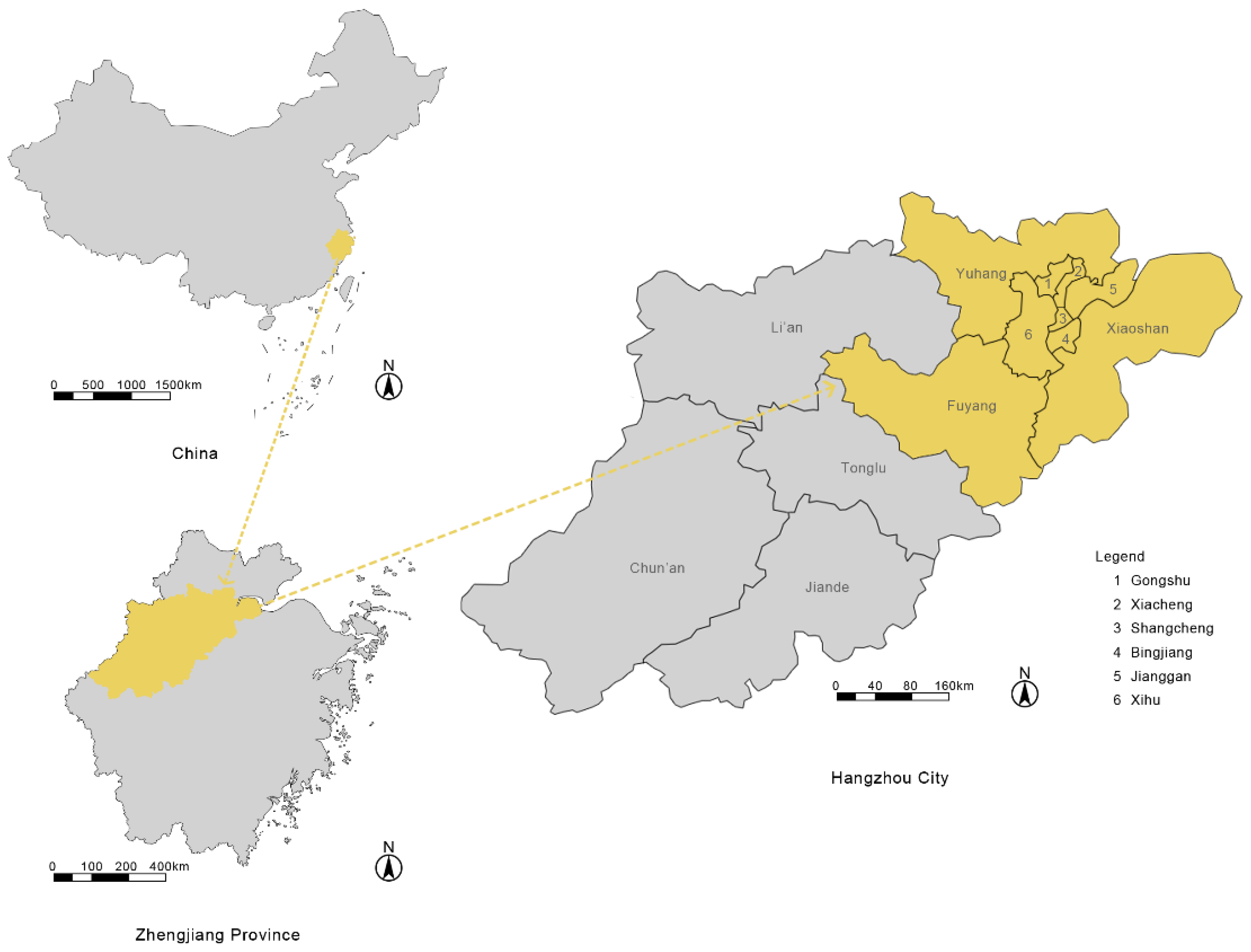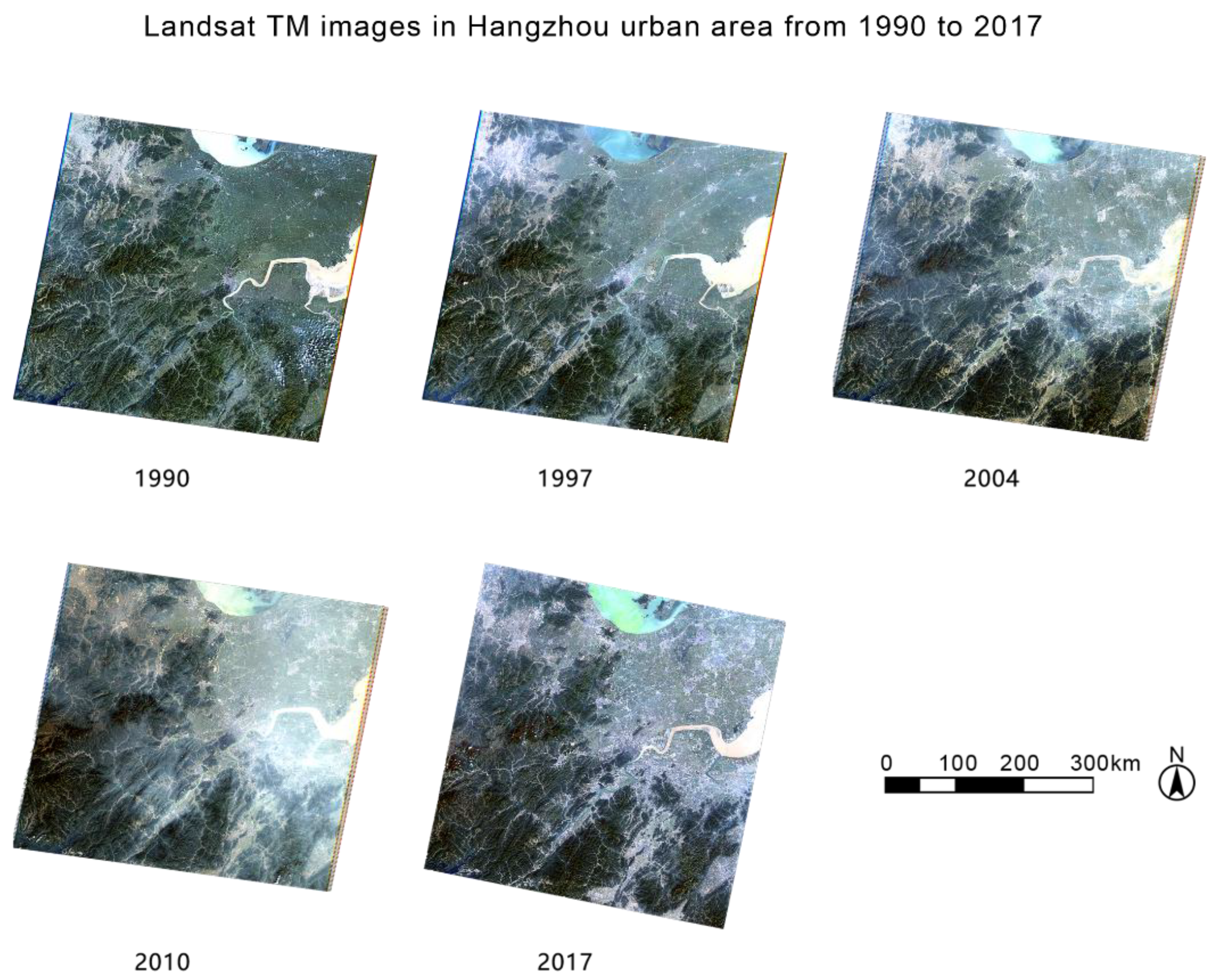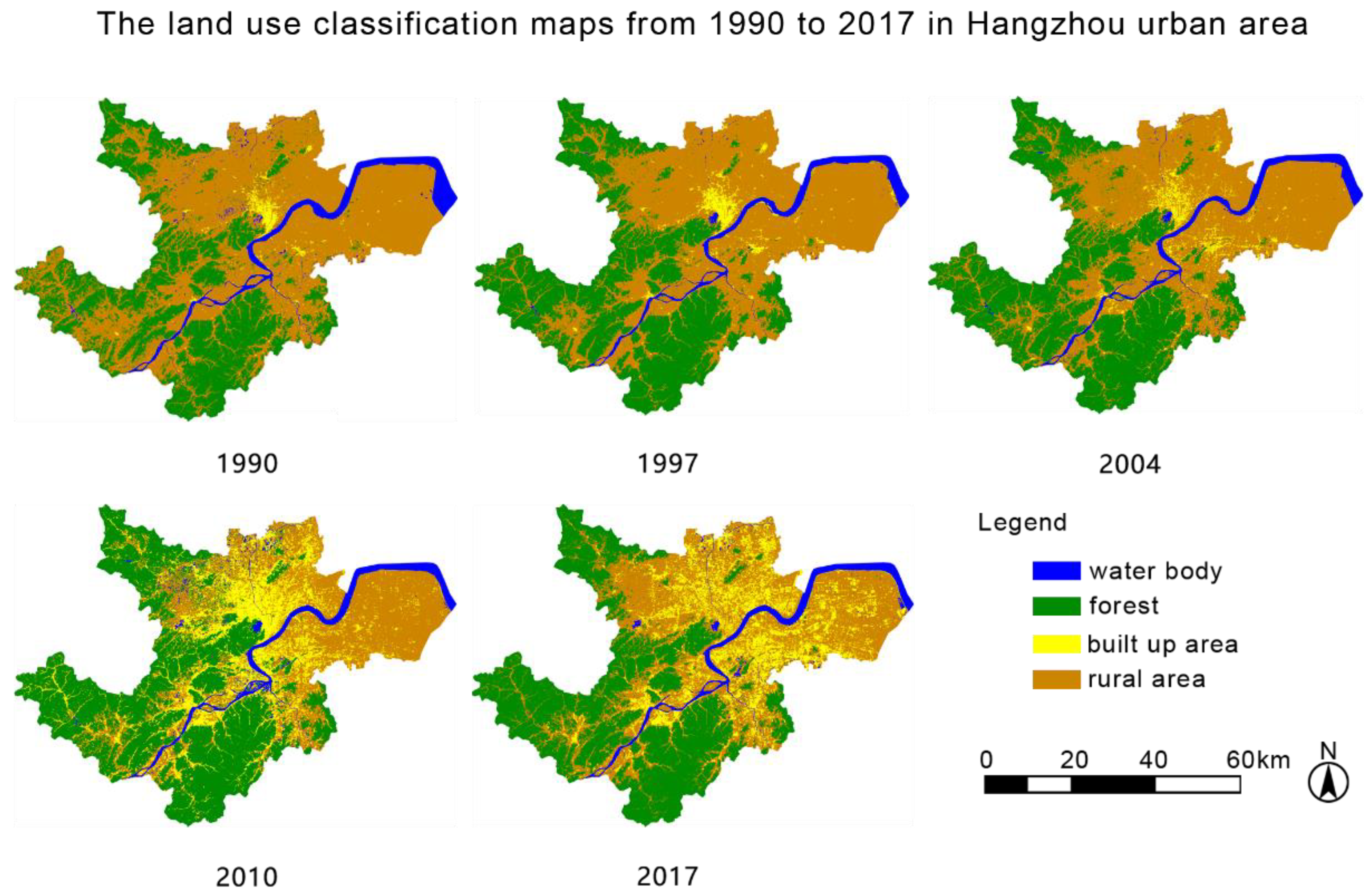Detecting Land Use Changes in a Rapidly Developing City during 1990–2017 Using Satellite Imagery: A Case Study in Hangzhou Urban Area, China
Abstract
:1. Introduction
2. Materials and Methods
2.1. Study Area
2.2. Data Collection
2.3. Methods
2.3.1. Images Classification by the Method of Supervised Classification
2.3.2. Analysis of Land Use Change Process by the Method of Markov Matrix
3. Results
3.1. Classification Results from 1990 to 2017
3.2. Classification Accuracy
3.3. Markov Matrix
4. Discussion
4.1. Analysis of Land Use Change from 1990 to 1997
4.2. Analysis of Land Use Change from 1997 to 2004
4.3. Analysis of Land Use Change from 2004 to 2010
4.4. Analysis of Land Use Change from 2010 to 2017
5. Conclusions
Author Contributions
Funding
Acknowledgments
Conflicts of Interest
References
- FAO. Global Forest Resources Assessment 2015; FAO: Rome, Italy, 2016. [Google Scholar]
- Song, W.; Deng, X. Land-use/land-cover change and ecosystem service provision in China. Sci. Total Environ. 2017, 576, 705–719. [Google Scholar] [CrossRef] [PubMed]
- Li, Y.; Sulla-Menashe, D.; Mottesharrei, S.; Song, X.P.; Kalnay, E.; Ying, Q.; Li, S.; Ma, Z. Inconsistent estimate of forest cover change in China between 2000 and 2013 from multiple datasets: Differences in parameters, spatial resolution, and definitions. Sci. Rep. 2017, 7. [Google Scholar] [CrossRef] [PubMed]
- Geist, H.J.; Lambin, E.F. Proximate causes and underlying forces of tropical deforestation. BioScience 2002, 52, 143–150. [Google Scholar] [CrossRef]
- Nepstad, D.C.; Stickler, C.M.; Almeida, O.T. Globalization of the Amazon soy and beef industries: Opportunities for conservation. Conserv. Biol. 2006, 20, 1595–1602. [Google Scholar] [CrossRef] [PubMed]
- Rudel, T.K. Tropical Forests: Regional Paths of Destruction and Regeneration in the Late Twentieth Century; Columbia University Press: New York, NY, USA, 2005. [Google Scholar]
- Bounoua, L.; DeFries, R.; Collatz, G.; Sellers, P.; Khan, H. Effects of land cover conversion on surface climate. Clim. Chang. 2002, 52, 29–64. [Google Scholar] [CrossRef]
- Bonan, G.; Pollard, D.; Thompson, S. Effects of boreal forest vegetation on global climate. Nature 1992, 359, 716–718. [Google Scholar] [CrossRef]
- Kleidon, A.; Fraedrich, K.; Heimann, M. A green planet versus a desert world: Estimating the maximum effect of vegetation on the land surface climate. Clim. Chang. 2000, 44, 471–493. [Google Scholar] [CrossRef]
- Giam, X. Global diversity loss from tropical deforestation. Proc. Natl. Acad. Sci. USA 2017, 114, 5775–5777. [Google Scholar] [CrossRef] [PubMed]
- Wang, L.; Li, C.; Ying, Q.; Cheng, X.; Wang, X.; Li, X.; Hu, L.; Liang, L.; Yu, L.; Huang, H.; et al. China’s urban expansion from 1990 to 2010 determined with satellite remote sensing. Chin. Sci. Bull. 2012, 57, 2802–2812. [Google Scholar] [CrossRef] [Green Version]
- National Bureau of Statistics of the People’s Republic of China. Statistical Bulletin on National Economic and Social Development in 2017; National Bureau of Statistics of the People’s Republic of China: Beijing, China, 2018.
- The Department of Economic and Social Affairs of the United Nations. World Urbanization Prospects 2018; The Department of Economic and Social Affairs of the United Nations: New York, NY, USA, 2018. [Google Scholar]
- Top 15 ‘new first-tier’ cities in China. China Daily. 15 May 2017. Available online: http://www.chinadaily.com.cn/business/2017top10/2017-05/15/content_29343927.htm (accessed on 8 June 2018).
- National Bureau of Statistics of the People’s Republic of China. The Forth National Census; National Bureau of Statistics of the People’s Republic of China: Beijing, China, 1990.
- National Bureau of Statistics of the People’s Republic of China. The Sixth National Census; National Bureau of Statistics of the People’s Republic of China: Beijing, China, 2011.
- Du, X.; Huang, Z. Ecological and environmental effects of land use change in rapid urbanization: The case of Hangzhou, China. Ecol. Indic. 2017, 81, 243–251. [Google Scholar] [CrossRef]
- Tian, Y.; Xia, Y.; Zhou, L.; Li, D. Land use and cover change simulation and prediction in hangzhou city based on CA-markov model. Int. Proc. Chem. Biol. Environ. Eng. 2015, 90, 108–113. [Google Scholar]
- Wu, K.; Ye, X.; Qi, Z.; Zhang, H. Impacts of land use/land cover change and socioeconomic development on regional ecosystem services: The case of fast-growing Hangzhou metropolitan area, China. Cities 2013, 31, 276–284. [Google Scholar] [CrossRef]
- Zvoleff, A.; Wandersee, S.; An, L.; López-Carr, D. Land use and cover change. In Geography, Oxford Bibliographies; Oxford University Press: Oxford, UK, 2014. [Google Scholar]
- Li, X. A review of the international researches on land use/land cover change. Acta Geogr. Sin. 1996, 6, 344–356. [Google Scholar]
- Lavalle, C.; Baranzelli, C.; Silva, F.B.E.; Mubareka, S.; Gomes, C.R. A high resolution land use/cover modelling framework for Europe: Introducing the EU-ClueScanner100 model. Lect. Notes Comput. Sci. 2011, 6782, 60–75. [Google Scholar]
- Turner, B.L., II; Lambin, E.F.; Reenberg, A. The emergence of land change science for global environmental change and sustainability. Proc. Natl. Acad. Sci. USA 2007, 104, 20666–20671. [Google Scholar] [CrossRef] [PubMed] [Green Version]
- Reidsma, P.; Tekelenburg, T.; Berg, M.M.; van den Alkemade, R. Impacts of land-use change on biodiversity: An assessment of agricultural biodiversity in the European Union. Agric. Ecosyst. Environ. 2006, 114, 86–102. [Google Scholar] [CrossRef]
- Honnay, O.; Piessens, K.; van Landuyt, W.; Hermy, M.; Gulinck, H. Satellite based land use and landscape complexity indices as predictors for regional plant species diversity. Landsc. Urban Plan. 2006, 63, 241–250. [Google Scholar] [CrossRef]
- Mao, D.; Keith, A. Cherkauer, impacts of land-use change on hydrologic responses in the great lakes region. J. Hydrol. 2009, 374, 71–82. [Google Scholar] [CrossRef]
- Searchinger, T.; Heimlich, R.; Houghton, R.A.; Dong, F.; Elobeid, A.; Fabiosa, J.; Tokgoz, S.; Hayes, D.; Yu, T.-H. Use of U.S. croplands for biofuels increases greenhouse gases through emissions from land-use change. Science 2008, 319, 1238–1240. [Google Scholar] [CrossRef] [PubMed]
- Li, J.; Li, C.; Zhu, F.; Song, C.; Wu, J. Spatiotemporal pattern of urbanization in Shanghai, China between 1989 and 2005. Landsc. Ecol. 2013, 28, 1545–1565. [Google Scholar] [CrossRef]
- Simwanda, M.; Murayama, Y. Spatiotemporal patterns of urban land use change in the rapidly growing city of Lusaka, Zambia: Implications for sustainable urban development. Sustain. Cities Soc. 2018, 39, 262–274. [Google Scholar] [CrossRef]
- Yu, W.; Zang, S.; Wu, C.; Liu, W.; Na, X. Analyzing and modeling land use land cover change (LUCC) in the Daqing City, China. Appl. Geogr. 2011, 31, 600–608. [Google Scholar] [CrossRef]
- Pazúr, R.; Bolliger, J. Land changes in Slovakia: Past processes and future directions. Appl. Geogr. 2017, 85, 163–175. [Google Scholar] [CrossRef]
- Li, X.; Yeh, A.G. Neural-network-based cellular automata for simulating multiple land use changes using GIS. Int. J. Geogr. Inf. Sci. 2010, 16, 323–343. [Google Scholar] [CrossRef]
- Deadman, P.; Robinson, D.; Moran, E.; Brondizio, E. Colonist household decision making and land-use change in the Amazon Rainforest: An agent-based simulation. Environ. Plan. B 2004, 31, 693–709. [Google Scholar] [CrossRef]
- Liu, J.; Liu, M.; Zhuang, D.; Zhang, Z.; Deng, X. Study on spatial pattern of land-use change in china during 1995–2000. Sci. China Ser. D 2003, 46, 373–384. [Google Scholar]
- Xin, W. Economic and Social Development Report on Hangzhou Metropolitan Circle (2007–2012); Social Sciences Academic Press: Beijing, China, 2013. (In Chinese) [Google Scholar]
- China Internet Information Center. Illuminating China’s Provinces, Municipalities and Autonomous Region. PRC Central Government Official Website. 2001. Available online: http://www.china.org.cn/english/features/43610.htm (accessed on 8 June 2018).
- Canning, D.; Pedroni, P. Infrastructure, long-run economic growth and causality tests for cointegrated panels. Manch. Sch. 2008, 76, 504–527. [Google Scholar] [CrossRef]
- Xiong, C.; Becmann, V.; Tan, R. Effects of infrastructure on land use and land cover change (LULC): The case of Hangzhou international airport, China. Sustainability 2018, 10, 2013. [Google Scholar] [CrossRef]
- Li, B.; Mayraz, G. Infrastructure spending in china increase trust in local government. Soc. Indic. Res. 2017, 132, 341–356. [Google Scholar] [CrossRef]
- Weng, Q. Land use change analysis in the Zhujiang delta of China using satellite remote sensing, GIS and stochastic modelling. J. Environ. Manag. 2002, 64, 273–284. [Google Scholar] [CrossRef]
- Michael, R.; Muller, J.M. A markov model of land-use change dynamics in the Niagara Region, Ontario, Canada. Landsc. Ecol. 1994, 9, 151–157. [Google Scholar]
- Wu, Q.; Li, H.; Wang, R.; Paulussen, J.; He, Y.; Wang, M.; Wang, B.-H.; Wang, Z. Monitoring and predicting land use change in Beijing Using remote sensing and GIS. Landsc. Urban Plan. 2006, 78, 322–333. [Google Scholar] [CrossRef]
- Cortes, C.; Vapnik, V. Support-vector networks. Mach. Learn. 1995, 20, 273–297. [Google Scholar] [CrossRef] [Green Version]
- Wang, Y.; Li, J. A review of land use/cover classification methods for remote sensing images. Remote Sens. Inf. 2004, 1, 53–59. [Google Scholar]
- Kumar, S.; Radhakrishnan, N.; Mathew, S. Land use change modelling using Markov model and remote sensing. Geomat. Nat. Hazards Risk 2014, 5, 145–156. [Google Scholar] [CrossRef]
- Cohen, J. A coefficient of agreement for nominal scales. Educ. Psychol. Meas. 1960, 20, 37–46. [Google Scholar] [CrossRef]
- Landis, J.R.; Koch, G.G. The measurement of observer agreement for categorical data. Biometrics 1977, 33, 159–174. [Google Scholar] [CrossRef] [PubMed]
- Zanotta, D.C.; Zortea, M.; Ferreira, M.P. A supervised approach for simultaneous segmentation and classification of remote sensing images. ISPRS J. Photogramm. Remote Sens. 2018, 142, 162–173. [Google Scholar] [CrossRef]
- Chen, W.; Wang, D.; Huang, Y.; Chen, L.; Zhang, X.; Sang, M.; Wang, F.; Liu, J.; Hu, H. Monitoring and analysis of coastal reclamation from 1995–2015 in Tainjin Binhai New Area, China. Sci. Rep. 2017, 7. [Google Scholar] [CrossRef]
- Mu, J.B.; Huang, S.C.; Lou, H.F. Effects of the large-scale reclamation project on hydro-dynamic environment in the estuary. Appl. Mech. Mater. 2012, 226–228, 2317–2322. [Google Scholar] [CrossRef]
- Peng, S.; Chen, L.; Li, T. Reforming China: Major events (1978–1991). In Enrich Series on China’s Economic Reform; Enrich Professional Publishing: London, UK, 2010. [Google Scholar]
- Zhou, J. Interpretation of urbanization mechanism with system theories. Urban Stud. 1997, 4, 51–54. [Google Scholar]
- Li, L.; Lu, D.; Kuang, W. Examining urban impervious surface distribution and its dynamic change in Hangzhou metropolis. Remote Sens. 2016, 8, 265. [Google Scholar] [CrossRef]
- Wei, Y.D. Planning Chinese cities: The limit of transitional institutions. Urban Geogr. 2005, 16, 200–221. [Google Scholar] [CrossRef]
- Lin, F.; Sun, Q.; Peng, Z.; Chen, X. The innovations in China’s primary health care reform: Development and characteristics of the community health service in Hangzhou. Fam. Med. Commun. Health 2015, 3, 52–66. [Google Scholar] [CrossRef]
- Zhang, L.; Yue, W.; Liu, Y.; Fan, P.; Wei, Y.D. Suburban industrial land development in transitional China: Spatial restructuring and determinants. Cities 2018, 78, 96–107. [Google Scholar] [CrossRef]
- Shi, K.; Chen, Y.; Yu, B.; Xu, T.; Li, L.; Huang, C.; Liu, R.; Chen, Z.; Wu, J. Urban expansion and agricultural land loss in China: A multiscale perspective. Sustainability 2016, 8, 790. [Google Scholar] [CrossRef]
- Yue, W.; Liu, Y.; Fan, P. Polycentric urban development: The case of Hangzhou. Environ. Plan. A 2010, 42, 563–577. [Google Scholar] [CrossRef]
- You, H. Assessing land ecological security based on BP neural network: A case study of Hangzhou, China. J. Comput. 2013, 8, 1394–1400. [Google Scholar] [CrossRef]
- Spiekermann, M.; He, Y.; Yang, J.; Pauleit, S. Hangzhou: Fast urbanization and high population growth. In Peri-Urban Futures: Scenarios Models for Land Use Change in Europe; Springer: Berlin, Germany, 2018. [Google Scholar]
- Viña, A.; McConnell, W.J.; Yang, H.; Xu, Z.; Liu, J. Effects of conservation policy on China’s forest recovery. Sci. Adv. 2016, 2. [Google Scholar] [CrossRef] [PubMed]
- Banister, D.; Liu, J. Urban transport and the environment, Hangzhou, China. In Case Study Prepared for Global Report on Human Settlements; Nairobi, United Nations, 2013. Available online: https://unhabitat.org/wp-content/uploads/2013/06/GRHS.2013.Case_.Study_.Hangzhou.China_.pdf (accessed on 8 June 2018).
- Huang, J.W.; Teng, W.; Galliers, R. Transitioning beyond the economic-environmental trade-off in the city of Hangzhou. In Proceedings of the Annual Meeting of the Academy of Management, Anaheim, CA, USA, 5–9 August 2016. [Google Scholar]
- Tsou, J.Y.; Gao, Y.; Zhang, Y.; Sun, G.; Ren, J.; Li, Y. Evaluating urban land carrying capacity based on the ecological sensitivity analysis: A case study in Hangzhou, China. Remote Sens. 2017, 9, 529. [Google Scholar] [CrossRef]
- Wang, H.; Zhang, Y.; Tsou, J.Y.; Li, Y. Surface urban heat island analysis of Shanghai (China) based on the change of land use and land cover. Sustainability 2017, 9, 1538. [Google Scholar] [CrossRef]
- Wong, K.; Zhang, Y.; Tsou, J.Y.; Li, Y. Assessing impervious surface changes in sustainable coastal land use: A case study in Hong Kong. Sustainability 2017, 9, 1029. [Google Scholar] [CrossRef]




| Date | Type of Image | No. of Bands | Sun Elevation (degree) | Sun Azimuth (degree) |
|---|---|---|---|---|
| 8 October 1990 | TM | 6 | 44.38789220 | 137.22180616 |
| 11 October 1997 | TM | 6 | 45.42697568 | 142.52459223 |
| 14 October 2004 | TM | 6 | 45.83292862 | 147.08323317 |
| 31 October 2010 | TM | 6 | 41.42500448 | 152.91220365 |
| 3 November 2017 | TM | 7 | 41.43678741 | 156.63973651 |
| B | |||
|---|---|---|---|
| Yes | No | ||
| A | Yes | a | b |
| No | c | d | |
| Landsat TM Images | Overall Classification Accuracy | Kappa Coefficient |
|---|---|---|
| 1990 | 97.6105% | 0.9621 |
| 1997 | 99.3119% | 0.9894 |
| 2004 | 96.3759% | 0.9444 |
| 2010 | 98.1455% | 0.9718 |
| 2017 | 92.6960% | 0.8941 |
| Land Use Type | Forest | Built up Area | Rural Area | Water Body | |
|---|---|---|---|---|---|
| Years and Change | |||||
| 1997 (compared with 1990) | Into the area (km2) | 1990.44 | 137.93 | 2853.50 | 223.41 |
| Out of the area (km2) | 1660.96 | 93.15 | 3170.12 | 281.04 | |
| Change area (km2) | 329.47 | 44.77 | −316.62 | −57.64 | |
| Change percentage (%) | 19.836 | 48.063 | −9.988 | −20.508 | |
| 2004 (compared with 1997) | Into the area (km2) | 2061.85 | 199.47 | 2713.24 | 230.71 |
| Out of the area (km2) | 1990.44 | 137.93 | 2853.50 | 223.41 | |
| Change area (km2) | 71.42 | 61.54 | −140.26 | 7.30 | |
| Change percentage (%) | 3.588 | 44.620 | −4.915 | 3.269 | |
| 2010 (compared with 2004) | Into the area (km2) | 2211.06 | 1050.55 | 1673.74 | 269.93 |
| Out of the area (km2) | 2061.85 | 199.47 | 2713.24 | 230.71 | |
| Change area (km2) | 149.20 | 851.08 | −1039.50 | 39.22 | |
| Change percentage (%) | 7.236 | 426.667 | −38.312 | 17.000 | |
| 2017 (compared with 2010) | Into the area (km2) | 2004.83 | 905.23 | 2057.79 | 237.43 |
| Out of the area (km2) | 2211.06 | 1050.55 | 1673.74 | 269.93 | |
| Change area (km2) | −206.23 | −145.32 | 384.05 | −32.50 | |
| Change percentage (%) | −9.327 | −13.833 | 22.946 | −12.039 | |
| 2017 (compared with 1990) | Into the area (km2) | 2004.83 | 905.23 | 2057.79 | 237.43 |
| Out of the area (km2) | 1660.96 | 93.15 | 3170.12 | 281.04 | |
| Change area (km2) | 343.86 | 812.07 | −1112.33 | −43.61 | |
| Change percentage (%) | 20.703 | 871.749 | −35.088 | −15.518 |
© 2018 by the authors. Licensee MDPI, Basel, Switzerland. This article is an open access article distributed under the terms and conditions of the Creative Commons Attribution (CC BY) license (http://creativecommons.org/licenses/by/4.0/).
Share and Cite
An, Y.; Tsou, J.Y.; Wong, K.; Zhang, Y.; Liu, D.; Li, Y. Detecting Land Use Changes in a Rapidly Developing City during 1990–2017 Using Satellite Imagery: A Case Study in Hangzhou Urban Area, China. Sustainability 2018, 10, 3303. https://doi.org/10.3390/su10093303
An Y, Tsou JY, Wong K, Zhang Y, Liu D, Li Y. Detecting Land Use Changes in a Rapidly Developing City during 1990–2017 Using Satellite Imagery: A Case Study in Hangzhou Urban Area, China. Sustainability. 2018; 10(9):3303. https://doi.org/10.3390/su10093303
Chicago/Turabian StyleAn, Yuqing, Jin Yeu Tsou, Kapo Wong, Yuanzhi Zhang, Dawei Liu, and Yu Li. 2018. "Detecting Land Use Changes in a Rapidly Developing City during 1990–2017 Using Satellite Imagery: A Case Study in Hangzhou Urban Area, China" Sustainability 10, no. 9: 3303. https://doi.org/10.3390/su10093303





